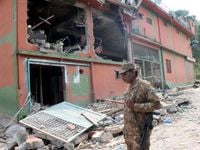Tensions between India and Pakistan have escalated dramatically, following India’s military strikes against sites in Pakistan and Pakistan-administered Kashmir on May 7, 2025. The strikes reportedly resulted in the deaths of at least 38 people, with dozens more injured. India claims the attacks targeted terrorist infrastructure, while Pakistan asserts the victims were civilians.
The strikes come in the wake of a terrorist attack in Kashmir that killed 26 people, including one Nepali, two weeks prior. The group Resistance Front (TRF), which India alleges is a proxy for the Pakistani-based terrorist group Lashkar-e-Taiba, claimed responsibility for the earlier attack. India has accused Pakistan of indirectly supporting the TRF, a claim that Pakistan vehemently denies.
In the aftermath of the military strikes, Pakistan’s National Security Committee has authorized its military to undertake corresponding actions in response. Prime Minister Shehbaz Sharif vowed, “We will avenge the blood of our innocent martyrs,” highlighting the heightened rhetoric from both sides.
The military exchanges have also led to heavy shelling along the Line of Control, which divides Indian- and Pakistan-administered Kashmir. Reports indicate that at least 31 people were killed and dozens more wounded in Pakistan’s Punjab province and the Kashmir region as a result of the strikes.
India’s military operation, dubbed “Operation Sindoor,” is particularly significant as it represents the first time India has struck targets in Punjab, a region considered the heart of Pakistan. This action has raised concerns about the potential for further escalation between the two nuclear-armed nations.
Historically, Kashmir has been a contentious issue between India and Pakistan, dating back to their independence from British rule in 1947. The region, which is rich in minerals and holds cultural significance for both countries, has been the focal point of multiple conflicts, including wars in 1965 and 1999. The UN-mediated ceasefire established in 1949 has been repeatedly tested over the decades.
In recent years, tensions have surged, particularly following incidents such as the 2016 Uri attack, which killed 19 Indian soldiers, and the 2019 Pulwama bombing that claimed the lives of over 40 Indian paramilitary personnel. Both incidents prompted Indian military responses, including surgical strikes across the Line of Control.
With both nations possessing nuclear capabilities—India holds approximately 180 nuclear warheads while Pakistan has around 170—the stakes are alarmingly high. Although India maintains a “no first use” policy regarding nuclear weapons, there are indications that this stance has been reconsidered since 2019. Conversely, Pakistan has never declared a no first use policy and argues that tactical nuclear weapons are essential for countering India’s larger conventional forces.
Experts warn that even a limited nuclear exchange could result in catastrophic consequences, potentially killing up to 20 million people within days. As both countries continue to escalate their military postures, the international community has expressed deep concern over the potential for a full-scale conflict.
Global leaders, including UN Secretary-General António Guterres, have called for restraint from both India and Pakistan. Guterres’s spokesman emphasized that “the world cannot afford a military confrontation between India and Pakistan.”
UK Foreign Secretary David Lammy echoed these sentiments, urging both nations to engage in direct dialogue to find a diplomatic resolution. U.S. President Donald Trump also weighed in, describing the situation as a “shame” and expressing hope for a swift resolution.
China’s foreign ministry labeled India’s military operation as “regrettable,” while France’s Foreign Minister Jean-Noël Barrot acknowledged India’s right to protect itself against terrorism but called for both sides to exercise restraint.
As tensions continue to mount, the lack of direct communication channels between India and Pakistan complicates the situation further. The absence of bilateral crisis management mechanisms raises the risk of miscalculations that could lead to disastrous outcomes.
In the wake of this latest escalation, analysts are closely monitoring the internal dynamics within both countries. In India, Prime Minister Narendra Modi’s government has received widespread approval for its military actions, which may bolster Modi’s standing amid declining popularity following the 2024 elections, where the ruling Bharatiya Janata Party (BJP) lost 63 seats in the Lok Sabha.
For Pakistan, the military’s historical influence over national security policy means that it may feel compelled to respond decisively to India’s actions to maintain its domestic legitimacy. As both nations navigate this perilous situation, the potential for conflict looms large, with the world watching closely.
Ultimately, the question remains whether cooler heads will prevail in the face of rising tensions. With the stakes so high, the need for diplomatic engagement has never been more critical to prevent a catastrophic escalation in South Asia.






